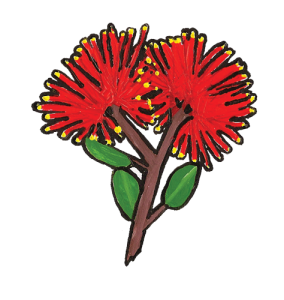1993
The seed of the idea
Enviroschools began as a small, seed-funded project in 1993, responding to the call from the 1992 Rio Earth to “think globally and act locally”. Initiated by members of the Hamilton Community Environmental Programme and supported by Hamilton City Council, Environment Waikato and the University of Waikato, three Hamilton primary schools trialled a number of projects to explore how to integrate Environmental Education into school life.
1997 – 2001
Enviroschools framework development
In 1997 Hamilton City Council employed their first Environmental Education Officer who led a team to fully develop the Enviroschools idea. Programme developers worked with a small number of enthusiastic and innovative schools from Waikato and Bay of Plenty, designing and trialled mapping techniques, experiential activities and student-centred decision-making tools.
Recognising the importance of integrating Māori perspectives led to a relationship with Te Mauri Tau – a Māori educational, environmental and health organisation based in Whaingaroa/Raglan. Through this core partnership came the development of the first Enviroschools Kit and facilitator training programme underpinned by five Guiding Principles and the Enviroschools Action Learning Cycle.
In 2001, with support from the Ministry for the Environment’s Sustainable Management Fund, the Enviroschools Programme became available nationwide.
2002 – 2003
National Partnership Building
As a nationally available programme Enviroschools moved from Hamilton City Council to be temporarily hosted by the National Association of Environmental Education (NZAEE), and in 2003 The Enviroschools Foundation was established. In partnership with Te Mauri Tau, The Enviroschools Foundation provided leadership and a strong organisational structure to build partnerships throughout New Zealand. During this period relationships were developed with a large number of Regional, City and District Councils, creating a strong support base to grow the facilitator network and bring new schools into the programme.
2004 -2006
Growth in Capacity
With an increasing strong support network there was huge growth in the number of participating schools. Regional networking events began to be developed and the first Green-Gold Enviroschools emerged and became role models for other schools. The programme began development into the Early Childhood and Secondary sectors.
In 2004 founding partner Te Mauri Tau began the development of what is now called Te Aho Tū Roa. Over the next few years development of Te Aho Tū Roa included the resource kit ‘Ko Au Ko Koe, Ko Koe Ko Au’, the Whakangungu training programme and Kōtuia! for rangatahi Māori.
2007 – 2012
Deepening and Extending into Community
As students in Enviroschools moved through from primary to intermediate and secondary schools Enviroschools developed to support them. National secondary school Youth Jams were held in 2007 and 2008 and this led to regional Jams and the establishment of ReGeneration, a youth-led network involving senior secondary and post-school youth. In 2009 ReGeneration moved out of The Enviroschools Foundation and formed its own trust to support a large number of youth-inspired projects.
The Enviroschools Kit was revised to incorporate the experience that had developed in the network.
International enquiries led to Enviroschools working with groups from Chile, Singapore, Brunei, Australia and later Argentina.
The withdrawal of Central Government funding in 2009 created a challenging time for the Foundation, and the Enviroschools national team reduced its support to the regions. The size and strength of the regional networks maintained the Enviroschools programme.
In 2010 we launched He Kete Taiao: Ko Au Ko Koe, Ko Koe Ko Au for Te Aho Tū Roa.
Due to support from The Māori Party, Central Government funding was reinstated in 2012.
2012 – 2015
Strengthening National Support and Building Regional Capacity
With renewed Central Government funding a range of support services were restored to the regions. A multi-level evaluation was undertaken of the Enviroschools Programme nationwide, including the first Enviroschools Census in 2014 where 73% (646) of Enviroschools responded. This was the largest ever Environmental Education survey in New Zealand and yielded a wealth of information for all participants in the network.
A regional capacity building fund was initiated to enable inter-regional support and sharing and increase the ability of regions to provide wider support for Enviroschools in their region.
Enviroschools worked with specific regions on ‘frontrunner’ projects to develop innovative ideas that had potential to contribute to the programme nationally.
During this time there was ongoing growth into the Early Childhood sector through partnerships with Kindergarten Associations.
2015 – 2018
A Maturing Nationwide Network
By 2015 The Enviroschools Foundation had grown from supporting a handful of primary schools to supporting nearly 1000 schools, kura and early childhood centres. Participants ranged from young children to secondary students, post-school youth and communities, in both English and Māori settings. To support this growing network we changed our name from The Enviroschools Foundation to Toimata Foundation.
Toimata is a concept from Dame Katerina Te Heikoko Mataira, evoking ideas of creativity, the arts, sustainability and vision. The takarangi design in the centre of the Toimata logo represents all present life nestled in the embrace of Ranginui and Papatūānuku. The horizontal flow represents the love that flows from all who have gone before and to all future generations.
Stepping into Toimata Foundation supported the continued growth of Te Aho Tū Roa and Enviroschools, and future new phases of development. During this time government funding was renewed for another 6 years. For Enviroschools the mahi included:
- Second Enviroschools Census
- Revision of key resources
- Regional events – Student events, collaborative projects
- Establishing specialist support for the Early Childhood sector

